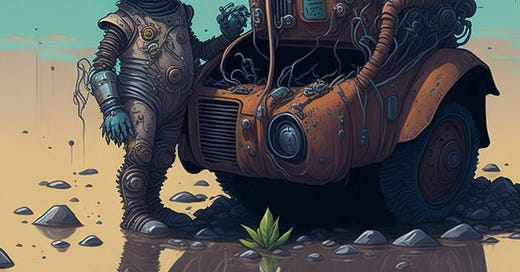Accidents Will Happen
A comparison of the infancy of cars and AI, and how can we learn from it.
The Infancy of Cars
As I listened to the latest episode of Reid Hoffman & Aria Finger’s POSSIBLE podcast, which focused on the Future of Cities, I was reminded of the impact that cars had on transportation, the job market, and even the configuration of cities. Similarly, the current state of AI has the potential to create major, permanent shifts in our world.
Janette Sadik-Khan describes how COVID and subsequent work-from-home habits changed NYC by opening up ideas that weren’t even possible before. For example, 10,000 parking spaces were freed up. Different European cities have also unveiled plans to repurpose streets and public spaces, turning some temporary changes into permanent features.
However, the adoption of motorized vehicles was neither smooth nor fast. It took over a hundred years from the first (fairly) viable vehicle until the first commercial gasoline-powered car was created by the Duryea Motor Wagon Company in 1896. Pioneers like the Duryea brothers, Alexander Winton, and Charles Brady King were pretty much bootstrapping the car-making industry back then. Public opinion was not in their favor, and they were being considered “fools fiddling with horseless buggies”. Driving at the beginning of the 20th century was extremely dangerous, and in two months of the summer of 1908, 31 people were killed in car crashes in Detroit alone. Then along came Henry Ford, introducing the moving assembly line, which changed the speed and consistency of manufacturing forever.
The Infancy of AI - So Far
The mass insertion of AI in the modern world is not without its hiccups, either. Trusted media sources were caught surreptitiously using AI writers, and careless employees pasted secret proprietary private information on ChatGPT without realizing anything posted there is no longer secret nor private. Prestigious educational institutions had to apologize after a PR snafu when employees used AI for very sensitive communications that really, really needed a human touch. Other companies tested chatbots in the live world, which almost instantaneously turned them racist. Or had to scrape AI hiring tools that were notoriously biased against women. And I’d be remiss not to mention the incident where an AI made an embarrassing mistake during its launch demo, which resulted in a 7% drop ($100bn) in the value of its parent company’s shares. And there will be more to come, and they will be bigger too.
But knowing that AI is inextricably part of our future, we should look at the mistakes made in the adoption of cars and learn to avoid replicating the multiple structural challenges arising from chaotic city development.
Big Technology Shifts Require Infrastructure Planning
Insufficient development planning in cities can lead to a number of structural challenges, such as traffic congestion, inadequate infrastructure, and environmental degradation. For example, many cities in developing countries have struggled to keep up with rapid population growth, resulting in inadequate transportation systems and congested roads. In Lagos, Nigeria, traffic congestion costs the city an estimated $1.2 billion annually, due to lost productivity and increased fuel consumption. Similarly, in Mumbai, India, inadequate infrastructure has led to slum settlements and poor living conditions for millions of residents. Environmental degradation is also a significant issue, with many cities struggling to manage waste and pollution. For instance, Delhi, India, is one of the most polluted cities in the world, with air pollution levels often exceeding safe limits. Without proper development planning, cities will continue to face these structural challenges, which can have significant social, economic, and environmental consequences.
AI Infrastructure Planning for the Future
AI also needs good planning of its infrastructure for its future development. Some recent efforts to press pause sound like a mix of honest concern about the uncontrolled development of technology and a desperate gasp of air to catch up to other, more advanced players. Europe is giving some serious thought to harder regulation of AI, including some countries banning ChatGPT altogether, albeit temporarily.
A seatbelt for AI
And in the same way that legislation around seatbelt usage has had a clear and positive impact on the survival rate in case of car accidents (it is estimated that seatbelt usage has saved around 375,000 lives in the US since 1975), governments should regulate ethics and safety aspects of AI to ensure there’s solid groundwork. Educational institutions and private efforts from the same companies developing the technology can also help. By the way, it should be noted that this would mean involving more AI ethicists, not less.
That way, we can ensure Sam Altman (CEO of OpenAI) and other mainstream AI founders do not go down in history as the equivalents to Thomas Midgley, Jr. (”the Most Harmful Inventor”) of this era.





